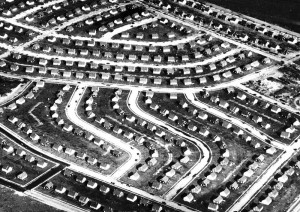Levittown
by student - October 28th, 2013
“Critics found the formulaic patterns stultifying but the residents got exactly what they wanted: affordable, well-built, single-family houses.” (Dunar, 177) This quote describes the attitude towards Levittown in the nineteen fifties. Levittown, a creation of Abraham (the father), William and Alfred Levitt, were mass-produced houses in urban areas. The Levitts had come up with the idea and started planning the production before and during World War II. This worked out perfect because by the time the war had ended the Levitt’s had perfected their production techniques and the returning veterans provided them with a positive prospective market. The way Levittown was produced resembled an assembly line production. The Levitt’s broke down the house construction process into twenty-seven steps. The first crew would lay out materials in specific designs at sixty-foot intervals across 4,000-acre plots. After the first step was done another crew would come along and stand the structure up, then another to do plumbing, then another to paint, and so on until the house was completed. This assembly line production method work well because it allowed the houses and towns to be put together quite rapidly compared to any other competition. Usually in one day the crews were able to complete thirty houses.
17,400 homes where available for 82,000 people by the time the project was completed. These homes were model for the suburbs, which was where many young families were now choosing to live since American’s were so mobile with automobiles then. Each home was sixty feet by one hundred feet and looked almost identical. The only differences in the houses were the paint colors (there was not much variety with the colors) or sometimes the side of the door the picture window was placed varied. Although, these houses were very similar and a bit small for a family, the people loved them. Those same facts were what allowed the Levittown houses to be sold so cheap and that was a big reason why so many people loved them. The houses had cost between $7,990 to $9,500, which was ideal for young couples ready to start a family. (Dunar, 177) One other factor that made Levittown so desirable was the thought of Levittown as a community. Most families, even still today, love a sense of community and the thought of friendly neighbors. Young parents loved looking at their future home in a Levittown and thinking of their future children playing outside among the other neighborhood children. <http://tigger.uic.edu/~pbhales/Levittown/a>
For the Levitt’s selling the houses was pretty easy. On selling days they would have lines of people waiting for their turn to try and purchase a house. It was because of the ease and hastiness that these houses were being sold that allowed the Levitt’s to be a bit picky in who they allowed to purchase these houses. The Levitt’s wanted to for an ideal community and therefore only allowed ideal people to purchase a home. If a man came through the line in grubby clothes and a grown out beard then the Levitt men would send him on his way with no house; but if that same man came back clean shave in a suit then the Levitt’s would sell him the house in a second. The Levitt’s clearly had the Levittown’s planned out, from the structure of each home, to the shrubbery, and even to the type of people living there. The Levittown was a very successful production and sparked a new and affordable way of living for many people in the nineteen fifties.
-Page M.

I cant believe how cheap the houses were. I think it is also interesting how these houses were built with families in mind. The Levittowns seems to stand for the America family and giving them the house they should have and always dreamed of. Seeing those feelings throughout America of cultivating families makes me think that it was an optimistic time.
Then, I get to Page’s last page where the Levitts were very picky about who could get their houses, and the hopeful feeling I had diminished. It is too bad that equality wasn’t as much of a priority as family life was.
It is hard to believe that there was ever a time when houses could be built and sold as quickly as the houses of Levittowns were. I can’t believe that these houses were only sold at around $7,990 to $9,500 a piece, when houses today can go on the market for millions and even billions of dollars. The idea of Levittowns is intriguing to me, but I also agree with Sara in saying that the discrimination against some of the prospective buyers was unfair.